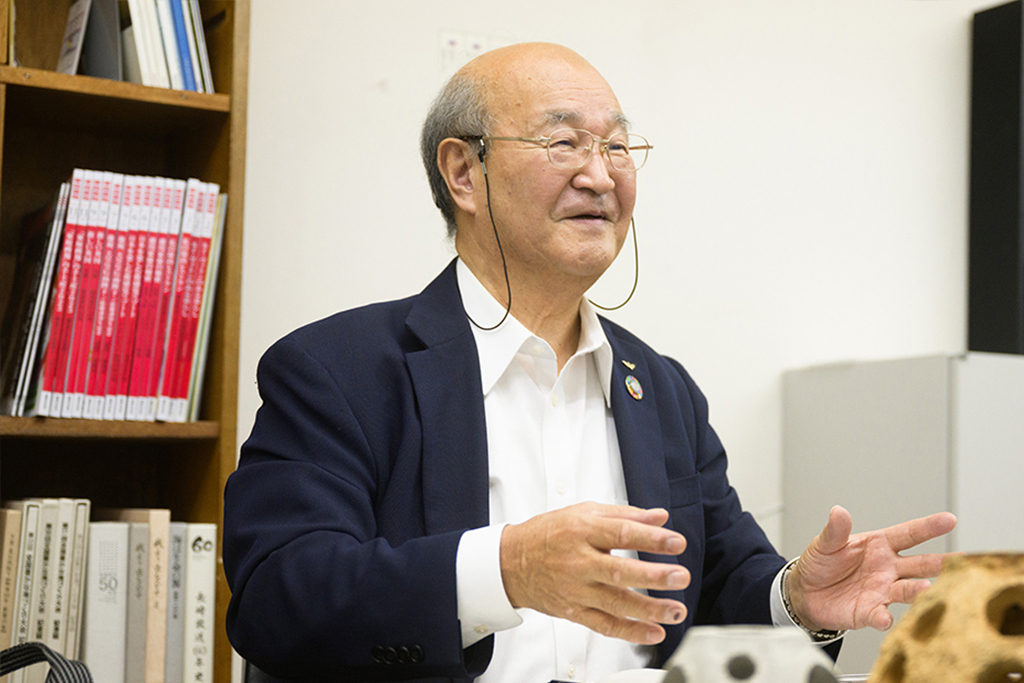Note: This website was automatically translated, so some terms or nuances may not be completely accurate.
Combating Global Warming with "Blue Carbon": The Potential of the Artificial Reef "Reef Ball" (Part 1)

Osamu Ikeda
Asahi Tech Co., Ltd.

Koji Fuji
Dentsu Inc.
Environmental destruction and the resulting global warming have become global challenges demanding immediate action. With July 2023 recording the highest global average temperature on record, the phenomenon is now being referred to not just as "global warming" but as "global boiling."
Following global initiatives, Japan is also undertaking various efforts toward carbon neutrality. Among these, "Blue Carbon" – carbon captured by marine ecosystems – is gaining significant attention. It is attracting worldwide interest as a measure that can simultaneously combat global warming and preserve the richness of the oceans.
Transformation SHOWCASE focuses on this "Blue Carbon." For this special feature, we spoke with individuals dedicated to expanding the use of artificial reefs called "Reef Balls," which are expected to have significant impact in the Blue Carbon field, and with officials from municipalities actively pursuing the SDGs. For the first installment, we visited Mr. Osamu Ikeda, President of Asahi Tech Co., Ltd., which promotes Reef Ball adoption in Nagasaki City. The interviewer is Mr. Takashi Fuji, who works on carbon neutrality and blue carbon initiatives at Dentsu Inc. This story is presented in two parts.
Encountering the "Reef Ball," Savior of Coral Reef Revival

Importing ReefBalls from the U.S. to Nagasaki

The "Reef Ball," increasingly seen as a promising solution for global warming. In Part 1, we heard from Mr. Ikeda of Asahi Tech about his journey from encountering the Reef Ball in America to launching the business in his hometown of Nagasaki. In Part 2, we bring you an interview about its promotion in Japan and a report from Asahi Tech's headquarters factory.
The information published at this time is as follows.
Was this article helpful?
Newsletter registration is here
We select and publish important news every day
For inquiries about this article
Author

Osamu Ikeda
Asahi Tech Co., Ltd.
President and CEO
Born December 11, 1949, in Nagasaki City, Nagasaki Prefecture. Graduated from Ritsumeikan University's Faculty of Industrial Sociology and Business Administration in 1972 (Bachelor of Business Administration) and joined Kobo Sho Co., Ltd. (Tokyo Headquarters). Relocated to New York in 1975 as Branch Manager for Nikko America Co., Ltd., and became Representative Director of Environmental Technology LLC in 1985. After returning to Japan in 2013, he became Representative Director of Asahi Tech Co., Ltd., a position he holds to this day. Service at UN Headquarters* 1980: Appointed Chairman of UN World Peace Bell Association USA Inc. (U.S. Public Interest Corporation) 1980–2013: Hosted the UN Headquarters Annual General Assembly Opening Ceremony.

Koji Fuji
Dentsu Inc.
Marketing Division 7, Solution Production Division 1
Chief Innovation Director
As a specialist in the environment and energy sector, I have been part of Dentsu Inc.'s cross-organizational unit DEMS for over 10 years, responsible for business development with domestic and international energy companies and startups. Since 2019, I have led the decarbonization and carbon neutrality domain, establishing "dentsu carbon neutral solutions" to coordinate and deliver group-wide carbon neutrality solutions and initiatives. Collaborated with internal and external members to develop behavioral change knowledge for decarbonized lifestyles using behavioral economics (nudge techniques) with the Ministry of the Environment, and to advance the Blue Carbon Project addressing coastal desertification—a critical issue for Japan as a maritime nation. Currently working daily toward the goal of positioning the 2025 Osaka-Kansai Expo as the "Ocean Expo," showcasing Japan's unique initiatives to the world.

